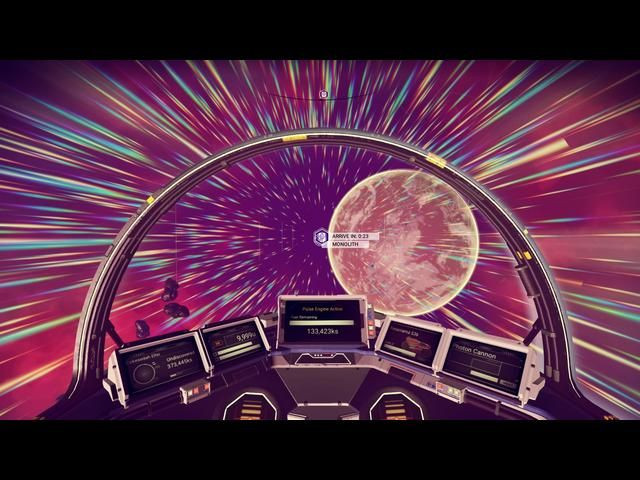Making No Man’s Sky impressions this early in the game's life cycle feels a bit like trying to review the original Star Wars trilogy while they’re still in the Mos Eisley cantina. Sure, you have a feeling it's going to be damn good stuff coming, but I can’t honestly say I know what the scope of my whole adventure is going to be. Of course, that doesn’t mean I have nothing to say. Quite the opposite in fact. Because I’m loving this game, and I’m happy to spread the gospel of No Man’s Sky.
For starters, don’t expect Destiny or Halo levels of action. Other than a middling space crab or two I didn’t run into any serious threats on the ground, and combat was limited to me zapping them with my multi-tool until they scurried off again. This isn’t a game about adrenaline-pumping action. It’s more like Pokemon Snap than Dead Space. There is some heart-stopping action, though, that comes by way of space pirates. Once you get off world you might be attacked by a gang of ships. Being chased to a space station with a cargo hold full of valuables that took hours to collect feels very real and very urgent.
But why Pokemon Snap? Because the crux of my No Man’s Sky gameplay so far has centered around scanning new lifeforms and minerals for upload into a giant database called the Atlas. Every time you upload something you earn money (units, as they’re called) and, if you want, you can rename your discovery too. This is where the galaxies of Harambes and Pen15 Club will come in, but there’s a pretty real physical limit on pranking the known ‘verse. I uploaded more than four dozen entries in just a few hours of gameplay, and didn’t want to take the time to rename every single one. Other than naming my starter planet “Roman Reigns” as a test for iDigi staff to see if multiple names are possible (they are) I didn’t customize anything else.
So what do you do in No Man’s Sky? You explore. Beyond finding new entries you look for wealth, resources and information. For wealth, you’ll be keeping an eye out for valuable minerals like emeril and titanium that you can sell at a Galactic Trading Post. Your resource hunts will be guided by the technology blueprints you pick up (and the early game task of rebuilding your warp drive). Generally, this means isotopes like plutonium and thamium and minerals like zinc and iron . These things fuel your ship and your spacesuit and, trust me, you don’t want to forget about them. It’s very easy to lose yourself in mining a rich vein of emeril or sprinting across the planet’s surface snapping Atlas entries. But when your ship can’t take off because you don’t have plutonium or your environmental protections are fading because you’re out of zinc, you’ll feel like a fool.
Information is the most valuable resource in No Man’s Sky, and the most rare. You’ll learn an alien language one word at a time courtesy of randomly placed knowledge stones, and encounter alien travellers scattered across abandoned outposts. They won’t offer much in terms of conversation, but most will offer an upgrade or reward of some sort if you manage to act appropriately. Although the language is alien, No Man’s Sky provides context clues in these interactions to give you an idea of how to respond. Meeting aliens and learning languages is the first step towards discovering the larger path of making it to the center of a galaxy, the long-stated “goal” of No Man’s Sky. But what you do when you get there, and what you find along the way, is a mystery. Solving it is the point of the game.
As far as what the gameplay is the flow, for me, went like this : land on a planet, scan everything in sight, then start walking. Keep an eye out for precious resources or use the range scanner to find “?” waypoints in the distance. After spending a few minutes in an area return to the ship, fly low and scout for anything that looks interesting (i.e. shelters and buildings), land, repeat. No Man’s Sky is certainly a familiar grind if you’ve ever played any of the other sandbox-crafting style games (Minecraft, Starbound, etc) but there’s something about the sheer size of it, and the breathtaking variety, that make it more than just “XYZ In Space.” It’s huge and wholly original and if you have the patience for a crafting game or a love of sci-fi discovery you won’t be disappointed.
At least not in the first six hours.


















